| Objective: |
For the final project in this course, you will build a complete game using the C4
Game Engine from Terathon Software. IMGD-3000
focuses on the technical aspects of game development, and IMGD-3500 focuses on the
artistic aspects. Therefore, it is the duty of the 3000 students to make sure the
result plays well with respect to the stated technical aspects, and of the 3500 students that
it looks good with respect to the stated artistic goals you will outline.
This project must be done in teams of four or five. Both the scope and
compressed timeline (only six weeks!) of this project require that the project be done in teams.
The desired outcomes of this project are as follows:
- To go through the process of developing a game of significant size
- To gain experience with a sizable game engine codebase
- To gain experience in team-based development
- To determine and follow a timeline of milestones that must be met to complete
a project of this size on time
- To get a good idea of what game development is all about
- To have fun!
There will be several, rapid milestones to be met along the way to delivering your
working product. These are listed below.
|
|
| Timeline: |
The timeline for significant milestones of the project is as follows:
- Nov. 01: Project summary ideas due
- Nov. 02: Project approved
- Nov. 05: Detailed Game Plan due
- Nov. 05: Project kickoff meeting!
- Nov. 06: SourceForge Project set up
- Nov. 07: Web page set up to show your progress
- Nov. 09: Basic game structure in place, characters and basic objects modeled an in game
- Nov. 12: Milestone 1: Progress presented in class
- Nov. 19: Milestone 2: Playable game alpha presented in class
- Nov. 20: Begin internal testing of implemented parts. Build, build, build!
- Nov. 26: Milestone 3: Playable game beta presented in class
- Dec. 06: Milestone 4: "Feature-complete" game, all major functionality in place.
No new ideas! Time to finish up and test, test, test!
- Dec. 12: Game complete. Go home and get some sleep before launch day.
- Dec. 13: GameFest 2007!
|
|
| Final Prototypes: |
We had two judges, Kent Quirk from Linden Lab and Michael Gesner
from Dragonfly Game Design, come to the final
presentations, and rate the performance of the groups on various criteria. The judges played
the role of Publisher, evaluated each team's presentation, and had "ONE MILLION DOLLARS!" to
distribute as they saw fit (okay, so there was no real money, but if you feel like it,
you could sponsor this event!).
The students also rated each other's games, and voted for the best in each category.
Keep in mind that the teams only had about 6 weeks to go from idea to prototype.
| FINAL PROJECTS |
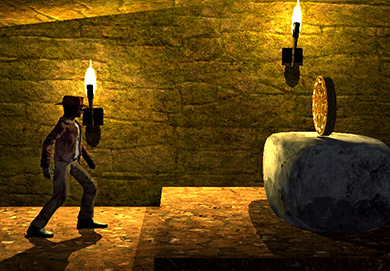
|
| *** BEST OVERALL (audience) *** |
|---|
| *** BEST ART (audience) *** |
|---|
| *** BEST TECH (audience honorable mention) *** |
|---|
| *** MOST FUN (audience honorable mention) *** |
|---|
The Monkey's Left Eye
A side-scrolling platformer set in a three-dimensional environment, The
Monkey's Left Eye requires the player to use classic two-dimensional
movement (such as running, jumping, climbing, and swinging) and timing to
get through traps, obstacles, and puzzles. The game will force the player to
think in terms of three dimensions rather than two, however, by providing
ways to change his or her orientation to the environment, such as pivoting
levers and viewpoint modifiers, and will incorporate puzzles that require
using these skills to be successful.
Team: Angry Ed Studios
Members:
Elisabeth Beinke (Art)
Alec Goebel (Tech)
Alex Schwartz (Art)
Dan Tennant (Art)
Dennis Valovcin (Tech)
Game Website
>>> DOWNLOAD THE GAME (308MB) <<<
ReadMe for playing the game
|
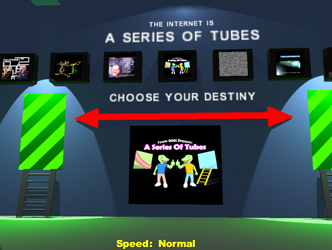
|
| *** BEST OVERALL (audience) *** |
|---|
| *** MOST NOVEL (audience) *** |
|---|
| *** MOST FUN (audience) *** |
|---|
| *** BEST SOUND (audience) *** |
|---|
A Series of Tubes
A first person multiplayer game, where each player attempts to reach
the end of a maze. The player will need to use spacial awareness and
problem solving to find their way through the maze. Each room will
have two ladders, which lead to two new rooms, and one "chute" which
the player may or may not be able to see, which will bring the player
back to a previous room. The game is a humorous take on the classic
board game, and is designed for players of all ages.
Team: Team 9001
Members:
Brian Hettrick (Art)
Pat McAnneny (Art)
Graham Pentheny (Tech)
Tim Poliquin (Tech)
Joe Strong (Art)
Game Website
>>> DOWNLOAD THE GAME (282MB) <<<
|
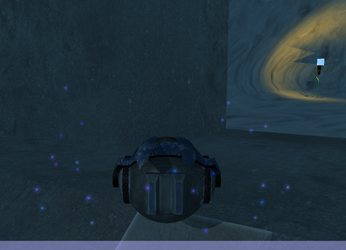
|
| *** BEST TECH (audience) *** |
|---|
| *** BEST OVERALL (audience honorable mention) *** |
|---|
| *** BEST ART (audience honorable mention) *** |
|---|
GeoLock
GeoLock is a 3D, third-person, puzzle game inspired by the
ancient Chinese game of tangrams. As the player, you are trapped
in an abandoned base built into a pre-existing maze of cavernous
ice tunnels. You try to find your way out, but your path is
frequently obstructed by large blast doors. The mechanism to open
the doors is still operational, however, ice crystals have begun
growing on the surface of the doors and prevent the doors from
sliding open. Running around the ice caverns you discover several
small, crystalline creatures which you can capture and manipulate
to help you escape.
Team: Screaming Goats
Members:
Karin Bryant Nova (Art)
Skyler Clark (Tech)
DC Corfman (Art)
Matt Fabian (Art)
Albert Lo (Tech)
Game Website
>>> DOWNLOAD THE GAME (65MB) <<<
ReadMe for playing the game
|
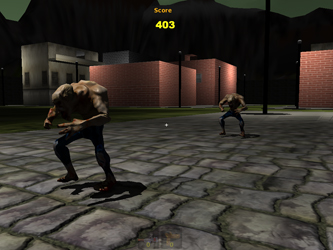
|
Zombie Cirisis
Survive as long as you can! The Town's inhabitants are looking for food,
and you're the only thing alive. Hide, defend, or repel your way to high
score in this arcade game of death defying fun.
Team: TeamUniverse
Members:
Eric Kolodziejczak (Art)
Alex Laferriere (Art)
Nelson Nogueira (Art)
Yi Wong (Tech)
Game Website
>>> DOWNLOAD THE GAME (130MB) <<<
ReadMe for playing the game
|
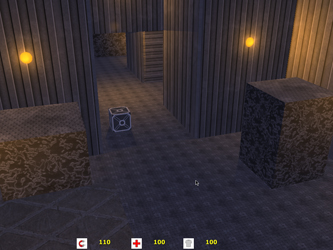
|
| *** MOST NOVEL (audience honorable mention) *** |
|---|
| *** MOST FUN (audience honorable mention) *** |
|---|
| *** BEST TECH (audience honorable mention) *** |
|---|
Magnets
Magnets is a first person action/puzzler. The character navigates through the
levels with the aid of transportation magnets. The player simply throws a
transportation magnet to a desired location and then activates their suit's
charge. This causes the player to be pulled to the magnet's location.
Team: Magnatech
Members:
Peter King (Art)
Jared Renzullo (Tech)
Nick Urko (Art)
Game Website
>>> DOWNLOAD THE GAME (187MB) <<<
ReadMe for playing the game
|
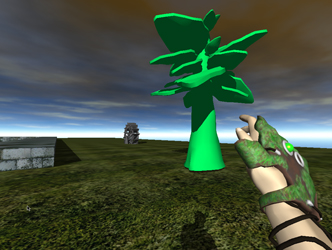
|
| *** MOST NOVEL (audience honorable mention) *** |
|---|
Elementist
This is a 3-D puzzle where the player uses elemental magic to
manipulate the environment in order to get to each level's
endpoint. Wielding a gauntlet/glove with element crystals, the
player is able to use just the individual elements (fire, earth,
water, and air), or to combine two elements to solve puzzles.
The puzzles are about using the elements to escape an area, and
allowing players the freedom to solve them in several different
ways.
Team: Moriarty Productions
Members:
Ross Doran (Art)
Ryan LaSante (Tech)
Tim Volpe (Tech)
Mary Yovina (Art)
Game Website
>>> DOWNLOAD THE GAME (219MB) <<<
ReadMe for playing the game
|
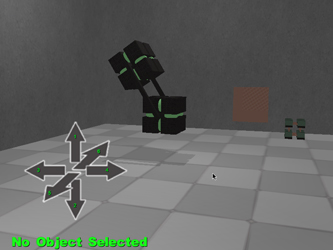
|
| *** MOST NOVEL (audience honorable mention) *** |
|---|
Gravitation
Gravitation is a FPS puzzle game where the player must employ his trusty Graviton Particle
Emitter to change the gravitation of objects as well as himself/herself in order to complete
the training course and continue to the odd world that awaits outside the doors of the test
facility. At first the player will just have the ability to change the direction of gravity,
but and the player make progression they will learn to effect the amount of gravity acting
on an object, or making it so that the object is not effected by gravity whatsoever.
Team: No Name
Members:
Tim Cushman (Art)
Sally Saba (Art)
Gary Schorer (Tech)
Shaun Tyman (Tech)
Game Website
>>> DOWNLOAD THE GAME (179MB) <<<
ReadMe for playing the game
|
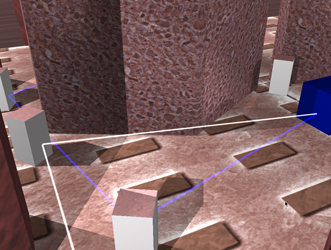
|
Prismatic
In the future, a Mars Rover discovers a vast underground power
network that uses light beams and mirrors to generate energy.
The rover's users must use the rover to realign things and
reactivate the systems.
Team: Bear Garden
Members:
William Barges (Art)
Ryan Bedell (Tech)
Aaron Breton (Art)
Edmund Dubois (Art)
Jason Stasik (Tech)
Game Website
>>> DOWNLOAD THE GAME (57MB) <<<
ReadMe for playing the game
|
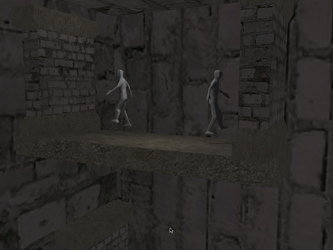
|
Reason And Revolution
Description: Reason And Revolution is a game in which you must
keep mindless drones on the path of life from accidentally
killing themselves. To do this, you're armed with your trusty
Wall/antiWall gun, to help build and destroy walls in the way
of the drones. More weapons and completely functionality in
completed release.
Team: None
Members:
Aaron Bell(Art)
Josh Brunelle(Art)
Evan Graziano (Art)
Bertrand Leduc (Tech)
Game Website
>>> DOWNLOAD THE GAME (117MB) <<<
ReadMe for playing the game
|
|
|
| Documentation: |
In order to make sure you gain experience with modern development and team-based tools, you must
use WPI's SourceForge for this project. Each team should, therefore, create a new project, and add all the team members,
in addition to both instructors and TAs, as administrators.
You must create adequate documentation, both internal and external, along with your assignment.
The best way to produce internal documentation is by including inline comments. The preferred way to do this
is to write the comments as you code. Get in the habit of writing comments as you type in
your code. A good rule of thumb is that all code that does something non-trivial should have comments
describing what you are doing. This is as much for others who might have to maintain your code, as for
you (imagine you have to go back and maintain code you have not looked at for six months -- this WILL
happen to you in the future!).
Create external documentation for your program and submit it along with the project. The documentation
does not have to be unnecessarily long, but should explain briefly what each part of your program does, and
how your filenames tie in.
NOTE: For this project, you must also include a document stating what each person on your team did towards
completing the project. This can be as simple as a list of deliverables, placing names
next to each one. Or it can be more precise. If you feel you would like to express your views individually, send
an email to the instructors.
|
|
What to
Turn in: |
Submit everything you need to run your program (source files, data files, etc.)
The command to archive everything, assuming your code is in a directory "final", is:
zip -r TeamName_final.zip final
Place this file in your SourceForge space, and label it as such.
|
|
| Useful Links: |
Here are some links to the final projects from previous offerings:
Here is a list of some ideas that might help you when working in groups:
|
|
Academic
Honesty: |
Remember the policy on Academic Honesty: You may discuss the
assignment with others, but you are to do your own work. The official WPI statement
for Academic Honesty can be accessed
HERE.
|
|

